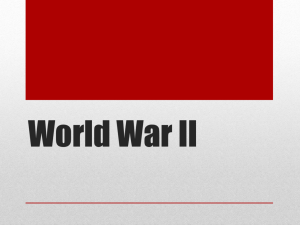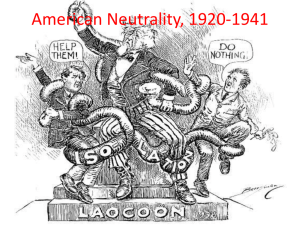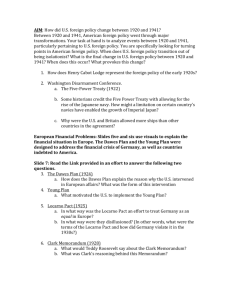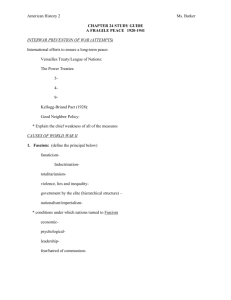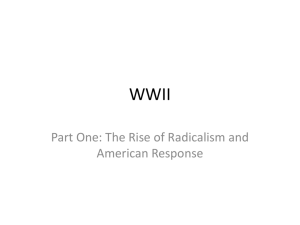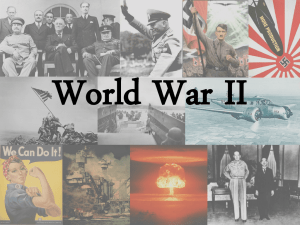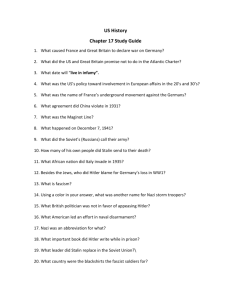WW2 PP-Part One
advertisement
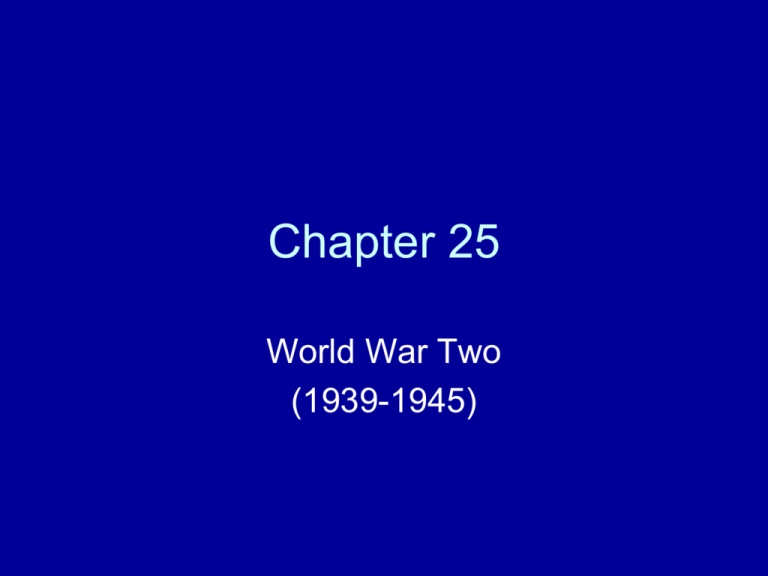
Chapter 25 World War Two (1939-1945) Rise of Dictators • Democracies weak after WW1 (huge war debts, unemployment, hunger, homelessness) • 1920’s - 1930’s dictators rise to power in both Europe and Asia • All believe in totalitarian governments (absolute control over its citizens) Faces of Totalitarianism • Benito Mussolini • Believed in Fascism • 1922 Il Duce: “the chief” of Italy • Goal: control the Mediterranean Sea and Middle East Faces of Totalitarianism • German soldier WW1 • Believed in Nazism, a type of Fascism • Published his beliefs in Mein Kampf • Goal: form a master race of “Aryans” to rule the world Faces of Totalitarianism • Joseph Stalin • “man of steel” • Succeeded Lenin as the Premier of the Communist Soviet Union 1924-1953 • Goal: spread worldwide communism Faces of Totalitarianism • General Francisco Franco • 1939 Fascist leader of Spain • Goal: restore Spain to prominence in Europe Faces of Totalitarianism • Hideki Tojo • Prime Minister of Japan 1941 • Totalitarian gov’t. • Goal: to control the Far East and Pacific Axis Powers Formed • 1935: Hitler violated the Treaty of Versailles and forms a military alliance with Italy (Rome-Berlin Axis Pact) • 1940: Japan joins the Axis Powers (Rome-Berlin-Tokeyo Axis Pact) • League of Nations did nothing to stop the aggression (Isolationism) Axis Powers • Which flag represents which country? • Which country was first to show signs of aggression? Dictators become aggressive • 1931 Japan invades Manchuria (why?) • 1935 Italy invades Ethiopia (why?) • 1936 Germany reoccupies the Rhineland (western Germany) (why?) • 1937 Japan attacks China (why?) • 1938 Germany invades Austria • 1938 Germany invades the Sudetenland (western Czech.) Italy invades Ethiopia Rhineland World War Two: 1939-1945 Isolationism • No one willing to challenge the aggressors. Why? • U.S. deep in their own domestic issues: Economic depression • Neutrality Laws passed by Congress (1935-1937). Designed to keep U.S. out of war. Isolationism • 1935 1st Neutrality Act: unlawful to sell weapons to countries at war • 1936 2nd Neutrality Act: unlawful to give loans or credit to countries at war • 1937 3rd Neutrality Act: unlawful to sell weapons to countries involved in civil wars (Spain) Munich Pact 1939 • Following Hitler’s invasion of the Sudetenland, four world leaders met to discuss German aggression • Neville Chamberlain (Great Britain) • Edward Daladier (France) • Benito Mussolini (Italy) • Adolf Hitler (Germany) Munich Pact • Hitler promised “no more aggression” if he could keep the land already occupied • Allies saw the policy as a victory for peace • Known as the Policy of Appeasement (does not work--must meet aggression head on) Russian-German Alliance • Aug. 1939: Non-Aggression Pact signed between Germany and USSR. – Will not fight each other – Will jointly invade Poland and divide it between the two countries • Why did Hitler sign this pact? • Why did Stalin sign this pact? Non-Aggression Pact • Germany will eventually break the pact on June 22, 1941 and invade the USSR • 3 million German soldiers will invade USSR • Does Germany succeed in taking over USSR? World War II Begins • Sept. 1, 1939: Germany invades Poland • Sept. 3, 1939: GB and France declare war on Germany and WW2 begins Introduction of Blitzkrieg • Lightning warfare • Dive bombers (stukas) used in first wave of attacks • Armored divisions (panzers) consisting of highly mobilized, mechanized tanks and mounted artillery used in second wave of attacks Blitzkrieg • What are the benefits of blitzkrieg? • What are the draw backs of blitzkrieg? • This is how warfare begins, even to this day. “Cash and Carry” • Nov. 1939, US reaction to the invasion of Poland was to pass 4th Neutrality Act called “Cash and Carry”. • Required the nations at war to pay cash and carry the goods themselves (on US shores) German Aggression continues • • • • • • • Following the invasion of Poland: Denmark Norway Netherlands Belgium Luxembourg France The Battle of Britain • Aug. 1940 Winston Churchill becomes new Prime Minister of G.B. • G.B. was last major country in Europe to conquer • Hitler’s first defeat • Royal Air Force, introduction of radar by British scientists save G.B FDR and the Lend-Lease Act • Congress approved the Lend-Lease Act in March, 1941. (G.B. out of cash) • FDR given unlimited authority to direct material aid to any country defending itself against the Axis Powers • rifles, machine guns, field guns, ammunition, destroyers, tanks, planes, trucks, food • 50 billion in all Lend-Lease • Initially intended for Great Britain • Expanded to include Soviet Union and China. • Intensely debated by Congress. Gave the president the power to decide what could be lent out and who could receive it US Prepares for War • Summer 1941: Selective Training and Service Act. Began the draft of men 2135. • First peacetime military draft • 16 million men drafted Election of 1940 • FDR broke the two term tradition set by George Washington • Ran against Republican Wendell Willkie • Both candidates promised to keep Am. Out of war • Very little difference between the two candidates Moving Towards War • Fireside Chat: U.S. had to help defeat the Axis threat by turning itself into “the great arsenal of democracy” • U.S. Navy ordered to protect lend-lease shipments. • FDR and Winston Churchill met secretly aboard a warship and signed The Atlantic Charter (war aims) Troubles with Japan • Japan’s goal was to dominate the Pacific • Colonial powers controlled the parts of the Pacific (GB, Fr., U.S.) • G.B. and France locked in a war in Europe • Only country in Japan’s way: U.S. U.S. reacts to Japan • 1939: U.S. began trade embargo with Japan • July 1941: U.S. cut off all trade with Japan. (crude oil, scrap iron, steel, cotton • Aug. 1941: U.S. froze all Japanese assets in U.S. War Inevitable • Nov. 5, 1941: Special “peace” envoy flew to Washington for talks • Same day Tojo ordered the Japanese navy to prepare for attack on U.S. • U.S. broke the Japanese secret military code and knew an attack was coming • Where would it be? Philippines, Guam? War Inevitable • Peace talks went on for a month • Dec. 6 decoded message instructed Japan’s peace envoy to reject all proposals. • “this means war” • Read page 563-564 Attack on Pearl Harbor • Nov. 25, 1941: 6 aircraft carriers, 2 battleships, 2 heavy cruisers, 11 destroyers left Japan. 423 planes on board carriers • Destination: U.S. Pacific fleet headquarters--Pearl Harbor Attack on Pearl Harbor • First Attack: 7:55 AM, Dec. 7, 1941 • “A day which will live in infamy” • “Air raid on Pearl Harbor. This is not a drill” • Second Attack: 8:45 AM • 2400 died, 1178 wounded • Stunning blow to U.S. fleet Pearl Harbor • Sunk 3 U.S. battleships (Arizona, Utah, W.Va) • One battleship capsized (Oklohoma) • 4 badly damaged • 350 planes destroyed/damaged • Japanese lost 29 planes • Japan struck Wake, Philippines, Guam, Midway, Hong Kong, Malay Peninsula U.S. goes to War • December 8, 1941: Congress declares war on Japan • Dec. 11, 1941: Germany and Italy declare war on the U.S.
